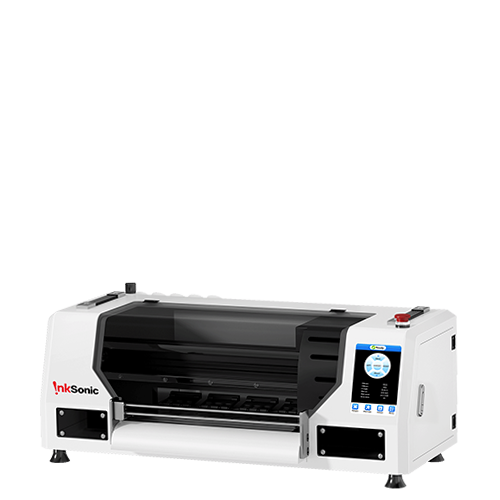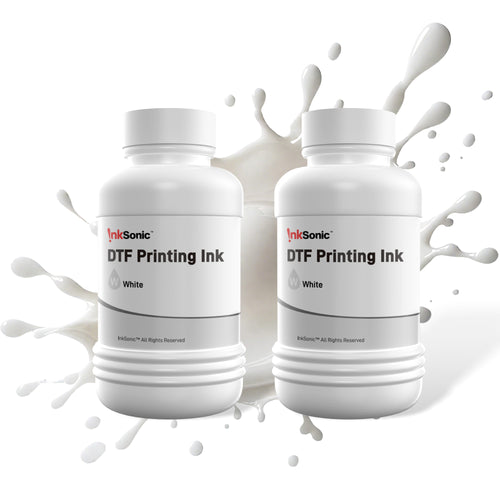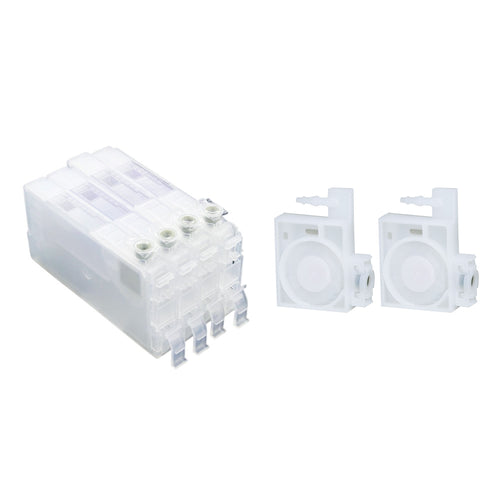UV 평판 프린터 기술의 힘을 열다: 그것이 무엇이며 왜 중요한가
인쇄 기술이 발전함에 따라 인쇄 산업은 패러다임 전환을 겪고 있습니다. UV 인쇄 기술은 경제적이고 환경 친화적이며 다재다능하기 때문에 변화의 중심에 서 있습니다.
모든 UV 프린터 중에서 UV 평판 프린터는 뛰어난 재료 호환성과 우수한 인쇄 품질로 돋보입니다. 이러한 특징 덕분에 광고, 포장, 홈 데코 산업에서 점점 인기를 얻고 있습니다. 오늘은 UV 평판 프린터 기술을 살펴보고 이 기술과 그 잠재적 이점에 대한 완전한 개요를 제공합니다.

UV 평판 프린터란?
자외선(UV) 경화 기술을 활용한 직접 잉크젯 프린터로, 판 없이 한 번의 인쇄로 풀컬러 모드를 구현합니다.
제품은 평판 프린터 프레스 위에 놓인 상태로 UV 잉크가 바로 분사됩니다. UV 광선이 비추어지면 잉크는 즉시 경화됩니다. 여러 개의 제품—다양한 디자인, 물체 또는 크기—을 동시에 인쇄할 수 있습니다. 필요한 것은 물체의 모든 면이 수평이고 평평하여 이미지가 정확하게 재현될 수 있어야 한다는 점뿐입니다. UV 프린터의 평판 설계는 유연성과 고해상도 출력이 요구되는 다양한 인쇄 작업에 이상적입니다.
작동 원리
UV 평판 프린터는 압전 잉크젯 인쇄 기술을 사용합니다. 작동 원리는 노즐을 통해 재료 표면에 UV 잉크를 분사하고 UV 램프로 즉시 경화 및 고정하는 것입니다. 노즐 내 압전 결정체는 전압에 반응하여 잉크 분사를 조절하고 분사량을 정확하게 제어합니다.
솔벤트 인쇄나 전통적인 열전사와 달리, UV 평판 인쇄는 고열을 사용하지 않는 냉경화 공정이며 유해한 솔벤트 가스가 발생하지 않아 친환경적입니다. 평판 디자인 덕분에 목재, 유리, 아크릴, 금속, 세라믹 타일 같은 비다공성 재료를 포함해 다양한 두께와 크기의 재료를 처리할 수 있습니다. 이 다재다능함은 전통 인쇄기 대비 뛰어난 장점입니다.

UV 평판 인쇄 대 UV DTF 인쇄
UV 평판 인쇄 외에도 UV DTF 인쇄도 주목받고 있습니다. 두 방식 모두 UV 잉크와 경화등을 사용하지만, 적용 방법은 크게 다릅니다.
차이점을 명확히 하기 위한 나란한 비교입니다:
| 비교 기준 | UV 평판 인쇄 | UV DTF 인쇄 |
| 인쇄 매체 | 거의 모든 재료 (목재, 금속, 유리, 아크릴 등) | 특수 접착 UV 필름, 이후 대상 재료에 전사 |
| 인쇄 방식 | 직접 표면 인쇄; 엠보싱 효과를 위해 흰색 잉크 자주 사용 | 필름에 CMYK + 흰색 잉크 + 바니시 인쇄; 밝기를 위해 더 많은 바니시 사용 |
| 바니시 사용량 | 더 많은 흰색 잉크, 더 적은 바니시 | 스티커 광택과 벗겨짐을 위한 더 많은 바니시 |
| 전처리 | 특정 표면(예: 유리, 세라믹)에는 프라이머 필요 | 프라이머 불필요—표면을 알코올로 닦기만 하면 됨 |
| 조작 용이성 | 복잡한 준비 과정; 대량 맞춤화에 적합 | 간단한 조작; 개인 맞춤 또는 소량 생산에 이상적 |
| 접착력 & 내구성 | 강한 직접 접착력; 실외 및 장기 사용에 적합 | 접착력이 다소 약함; 단기 또는 실내 장식용에 적합 |
장점
판 제작 불필요 – 효율적인 맞춤화
UV 평판 인쇄는 전통적인 판 제작 없이 직접 이미지 출력이 가능하며, 소량 맞춤 생산과 대량 제조 모두에 적합하여 시간과 비용을 크게 절감합니다. 단품과 대량 생산 간 비용 차이가 거의 없어 사용자는 단기 주문을 더 경제적이고 효율적으로 처리할 수 있어 더 많은 비즈니스 기회와 수익을 창출할 수 있습니다.
빠른 경화 속도 – 향상된 생산성
UV 경화 잉크 덕분에 인쇄물이 경화 즉시 건조되어 즉시 취급 가능하며 생산 속도가 빨라집니다.
광범위한 호환성 – 다양한 물체 형태 지원
물체 표면이 평평하고 정렬되어 있는 한, UV 평판 프린터는 디자인이나 크기에 관계없이 여러 개의 아이템을 한 번에 인쇄할 수 있습니다.
다양한 재료와 호환 가능
UV 평판 프린터는 단단하고 평평하거나 약간 질감이 있는 표면에 인쇄하는 데 뛰어납니다. 그러나 유연한 롤 재료, 열에 민감한 품목 또는 복잡한 곡면은 다른 방법이 필요할 수 있습니다.
호환 가능한 재료:
단단한 평면 재료: 유리, 금속, 목재, 플라스틱, 세라믹/타일, 석재
산업용 특수 재료: 전자기기 케이스, 간판, 자동차 부품
- 일부 부드럽거나 얇은 재료(고정 또는 장착 포함): 가죽, 단단한 카드지, 얇은 아크릴 시트
고품질 이미지 출력
디지털 잉크젯 기술을 사용하여 고해상도 출력과 진정한 색상 재현, 선명한 이미지 디테일을 제공합니다. 풀컬러 이미지는 한 번의 인쇄로 완성되며 자연스러운 그라데이션과 사진 품질 효과를 구현합니다. 위치 지정이 정확하고 결함률은 거의 없습니다.
에너지 효율적이고 친환경적
UV 경화 잉크는 경화를 위해 고열이 필요 없으므로 전체 에너지 소비가 적습니다. 또한 유해한 휘발성 물질을 배출하지 않아 친환경 제조 관행에 부합합니다.
실생활 적용 사례
우수한 이미지 품질, 재료와의 높은 적합성, 효율적인 즉시 경화 덕분에 UV 평판 인쇄는 여러 산업 분야에서 널리 활용됩니다. 산업용 대량 생산뿐 아니라 단기 맞춤 인쇄에도 조절 가능하고 친환경적이며 효율적인 솔루션을 제공합니다.
광고: 간판, 옥외 광고, 라이트박스, 전시 자료 등 빠른 업데이트와 고해상도 시각 효과가 필요한 모든 곳에 사용됩니다.
건설 및 인테리어 디자인: 유리, 타일, 목재 패널 등에 인쇄된 패턴으로 특색 있는 벽, 캐비닛, 미닫이문, 천장 등 맞춤 장식에 활용.
전자 및 디지털 기기: 휴대폰 케이스, 헤드폰, 키보드, 보조 배터리용 맞춤 디자인—제품 가치를 높임.
문화 및 창작 산업: 예술 복제, 캔버스 장식, 맞춤 선물—창작자가 고품질 복제를 실현할 수 있도록 지원.
포장 및 제조: 박스, 플라스틱 랩, 금속 케이스용 맞춤 포장; 빠른 디자인 전환과 소량 생산 지원.

필요한 이유
UV 평판 프린터의 원리, 장점, 광범위한 적용 범위에 대해 알게 된 후, 이 기술이 내 사업에 적합한지, 투자할 가치가 있는지 궁금할 수 있습니다.
개인 맞춤형/커스텀 제품 사업을 운영할 때
휴대폰 케이스, 코스터, 홈 데코 아이템 또는 선물을 개인화하든, 고객은 아마도 "개인적인" 터치를 원할 것입니다. UV 평판 프린터는 나무, 유리, 금속 등 어떤 표면에도 인쇄할 수 있게 해줍니다. 이는 다양한 소량 주문에 가장 적합하여 높은 비용과 복잡한 절차 없이 고객 주문을 쉽게 처리할 수 있습니다.
전통적인 인쇄 방식에서 업그레이드를 원할 때
과거에는 스크린 인쇄나 열전사에 의존하는 것이 일반적이었지만, 그 시절은 빠르게 사라지고 있습니다. 요즘은 유연성, 속도, 지속 가능성이 더 중요해졌습니다. UV 인쇄는 판이 필요 없기 때문에 시간과 비용이 줄고 더 많은 자유를 제공합니다. 고객 주문을 처리하든 사내에서 디자인 샘플을 만들든 이 기술은 과정을 더 원활하고 저렴하게 만듭니다.
빠르게 프로토타입이나 샘플이 필요할 때
디자이너, 제작자, 소규모 스튜디오는 잘 압니다—아이디어가 있을 때 빠르게 실현하는 것이 중요하다는 것을. 고해상도, 색상 정확한 결과물을 빠르게 출력하는 신뢰할 수 있는 조력자로서 테스트, 반복, 아이디어 실현을 지체 없이 도와줍니다.
당신의 브랜드가 진정으로 돋보이길 원한다면
오늘날 붐비는 시장에서 독특해 보이는 제품이 우위를 점합니다. 포장, 케이스, 표면 디자인 등 어디든 맞춤형 눈길을 끄는 시각적 요소를 추가해 제품이 돋보이고 고객의 기억에 남도록 합니다.
게다가 UV 평판 프린터는 가성비가 뛰어납니다. 전통 인쇄기보다 초기 자본이 적게 들며, 빠르게 자리 잡거나 사업을 확장하려는 중소기업에 특히 적합합니다. 주문을 통해 짧은 시간 내에 투자 수익을 실현할 수 있습니다.
필요 여부는 맞춤화 능력 향상, 생산 속도 증가, 창의성 실현, 사업 개발 준비 여부에 달려 있습니다. 그렇다면 이 기술에 투자할 시기는 지금입니다.
개인 맞춤 인쇄 시대를 맞이하며
소비자들이 점점 더 개별화되고 맞춤화된 제품을 요구함에 따라 UV 평판 프린터는 오늘날 디지털 인쇄의 선택지입니다. 판 제작 불필요, 다양한 재료 활용 가능, 즉시 건조, 친환경성 등 장점으로 전통 인쇄의 제약을 넘어 생산 유연성과 이미지 품질을 크게 향상시켜 줍니다.
포장, 문화 창작, 예술, 광고, 건설 또는 디지털 액세서리에 관계없이 UV 평판 프린터는 더 넓은 응용과 더 큰 창의성을 누립니다. 더 높은 효율성, 낮은 비용, 향상된 시장 경쟁력이 필요하다면 UV 평판 프린터가 맞춤형 비즈니스의 디지털 업그레이드와 사업 확장의 첫걸음이 될 수 있습니다.
이것은 단순한 기술적 선택이 아니라 생산 및 비즈니스 모델의 혁명입니다. 지금이 "인쇄"가 당신에게 무엇을 의미하는지 재정의할 순간입니다.
































